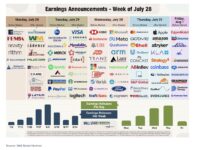 by Greg Naylor February was an eventful month for U.S. financial markets, as conflict in the Ukraine rattled investors and news from China continued with worries about corporate defaults spreading and measures of credit risk continued to elevate. The U.S. stock market did manage to reverse its losses of January, while bonds moved slightly higher. Here is what happened in the capital markets, by the numbers:
by Greg Naylor February was an eventful month for U.S. financial markets, as conflict in the Ukraine rattled investors and news from China continued with worries about corporate defaults spreading and measures of credit risk continued to elevate. The U.S. stock market did manage to reverse its losses of January, while bonds moved slightly higher. Here is what happened in the capital markets, by the numbers:
Stocks & Bonds
In February the U.S. stock market recovered its January losses, and then some. International stocks did the same, while bonds continued to move higher. Unseen in the data below is the volatility in many commodities and emerging markets, which so far has not overly affected the U.S. financial markets. By the numbers:
| S&P 500 Total Return | MSCI EAFE | BarclaysAggregateBond | Unadjusted CPI | |
| February | 4.57% | 5.34% | 0.53% | 0.37 |
| January | -3.46% | -4.07% | 1.48% | -0.01 |
| YTD 2014 | 0.96% | 1.05% | 2.02% | 0.36% |
Commodities & Currencies
After declining slightly in January, NYMEX crude rose 6.08% in February. This reflected, at least in part, fears of a Russian supply disruption due to Ukraine conflict. Russia is one of the world’s top oil producers, on par with Saudi Arabia and the United States. Also fuelled by concerns of military conflict, gold gained 6.6%, adding to its January gains and closing up about 9.9% year-to-date. The dollar index declined 1.81%, giving up its gains of January to close nearly flat for the year.
Economy
The Department of Commerce released its second estimate of 4th quarter GDP. They estimated that the economy grew at a 2.4% annual rate in the month of January, lower than the 3.2% estimate that was initially released. The effects of the sequester continued to subtract from growth, as did a relative slowdown in residential construction. The construction slowdown was likely due to both higher mortgage rates and a particularly difficult winter. It remains to be seen whether this will have a material effect on the U.S. financial markets.
The unemployment rate ticked up to 6.7% in February, from 6.6% in January. Total nonfarm payroll employment rose by 175,000, weaker than the monthly average of the previous year (189,000). Long-term unemployment and involuntary part-time employment (i.e. those who are working part-time only because they cannot find full-time work) both remain at historically high levels.
The Institute for Supply Management had continued good news, reporting that February’s manufacturing PMI was 53.2, up from January’s 51.2. A reading above 50 indicated economic expansion.
The National Association of Realtors (NAR) reported that the annual rate of existing-home sales in January fell by 5.1% from January 2013. This likely shows the effects of rising mortgage rates as well as a challenging winter (or as we call it in Minnesota, ‘early spring’). The national median price rose from the prior year by 10.7% to $188,900. Foreclosures and short-sales, as a percentage of overall sales, were at 15%, a slight uptick from December.
U.S. Financial Markets Summary
Year-to-date, optimism in the stock market has interacted with bad news from the Ukraine and China to cause volatility, but so far we have seen no large net changes in the S&P 500. Bonds, on the other hand, have been slowly regaining some of the ground they lose in 2013. Although we are not long-term bearish on the stock market, it has been quite a while since we have had a true correction, or even a bear market. One area of concern we are watching is risk premiums in China, which are rising rapidly. These are the prices that bond investors pay for insurance against bond defaults. We saw a similar increase in risk premiums in the U.S. credit markets prior to the financial crisis in 2008. The Chinese economy is structured much differently than the U.S. economy, but nonetheless, we are watching developments closely.
This material was prepared by Greg Naylor, and does not necessarily represent the views of Woodbury Financial or its affiliates. This information should not be construed as investment, tax or legal advice and may not be relied upon for the purpose of avoiding any Federal tax liability. This is not a solicitation or recommendation to purchase or sell any investment or insurance product or service, and should not be relied upon as such. The S&P500, MSCI EAFE and Barclays Aggregate Bond Index are indexes. It is not possible to invest directly in an index.
Investing involves risks and investors may incur a profit or a loss. Past performance is not an indication of future results. There is no guarantee that a diversified portfolio will outperform a non-diversified portfolio in any given market environment. No investment strategy can guarantee a profit or protect against loss in periods of declining values.
Data Sources:
- www.standardandpoors.com – S&P 500 information
- www.msci.com – MSCI EAFE information
- www.barcap.com – Barclays Aggregate Bond information
- www.bloomberg.com – U.S. Dollar & commodities performance
- www.realtor.org – Housing market data
- www.bea.gov – GDP numbers
- www.bls.gov – CPI and unemployment numbers
- www.commerce.gov – Consumer spending data
- www.napm.org – PMI numbers
- www.bigcharts.com – NYMEX crude prices, gold and other commodities
- https://data.bls.gov/timeseries/LNS11300000 – Labor participation data
About Greg Naylor: Greg is a partner and co-founder of Fiat Wealth Management, an independent financial advisory firm in Long Lake, Minnesota. He has been investing for over 7 years and enjoys sports, reading, singing, and spending time with family. Greg is a 2004 graduate of the University of Minnesota and lives in South Minneapolis with his wife Kat.
Any opinions expressed herein are solely those of the author and do not in any way represent the views or opinions of any other person or entity.








